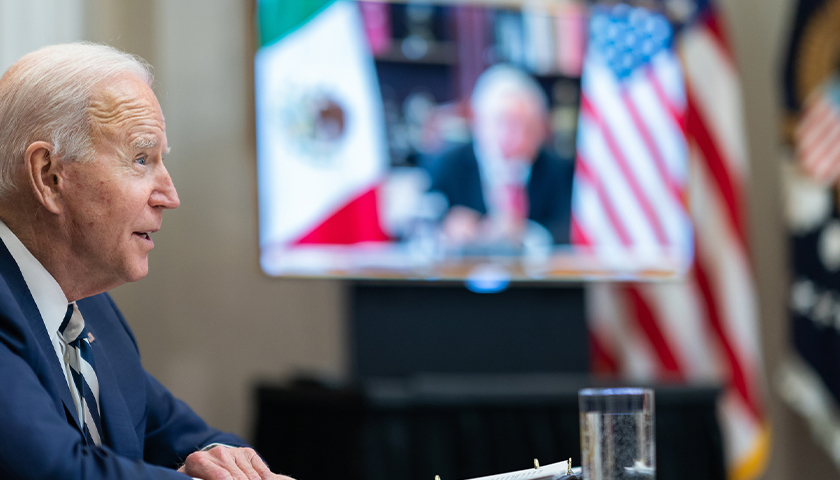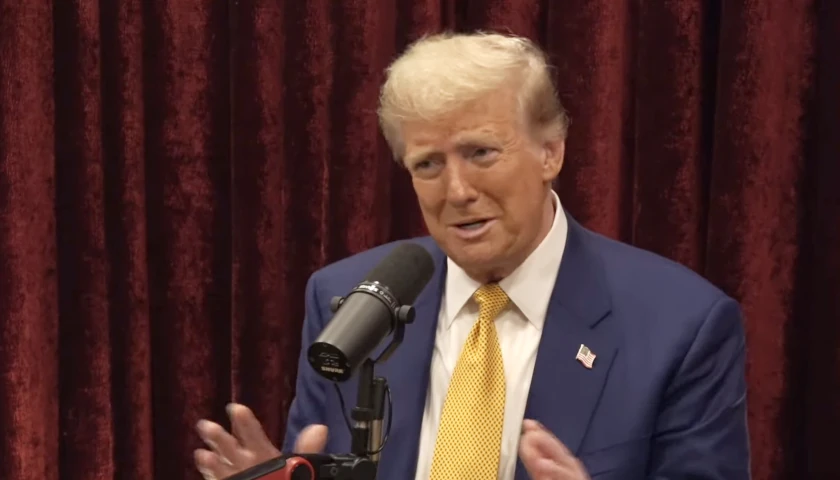by K.S. Bruce
Along with a working vaccine, Joe Biden inherited a V-shaped economic recovery, but he is now planting the seeds of its destruction. Inflation, federal deficits, high taxes, incentives for workers to stay home, and incentives to avoid investment – they’re all coming back. Together, these elements create the perfect brew for a Lyndon Johnson-style stagflation. If Biden and the Democrats so quickly wreck the good economic path they were given, it will be one of the worst examples of government malpractice in U.S. economic history.
In the first, dark days of the COVID-19 national economic shutdown last spring, there was a clear need for major stimulus. Both parties united to pass an effective and much-needed response.
The U.S. gross domestic product saw a 33.4% surge in the July-September third quarter of 2020, after plunging 31.4% in the April-June second quarter. The economy continued to grow at a 4% rate in the fourth quarter, and the stock market (despite COVID) ended 2020 with the S&P 500 index up 16% for the year as a whole.
Biden and the Democrats have since passed or proposed $6 trillion in additional stimulus spending – the $1.9 trillion “American Rescue Plan,” the $2.3 trillion “American Jobs Plan,” and the $1.8 trillion “American Families Plan.” As partial payment, corporate taxes are set to rise by one-third (from 21% to 28%). The top capital gains tax rates on investment are set to approximately double (from about 20% to about 40%). There is no relief for state and local tax expenses, which are also rising.
The extra stimulus is already beginning to show up in the form of inflation – too much money chasing too few goods. “We are seeing substantial inflation,” Warren Buffett declared at his annual shareholders meeting. “We are raising prices. People are raising prices to us, and it’s being accepted.”
Other CEOs are reporting the same facts. According to Bank of America’s Savita Subramanian, the number of mentions of “inflation” in shareholder earnings calls has tripled year over year, the biggest jump since 2004. “Inflation is arguably the biggest topic during this earnings season, with a broad array of sectors (consumer/industrials/materials, etc.) citing inflation,” Subramanian has said. Such mentions generally lead the consumer price index by a quarter or two.
Signs of inflation are clear. The price of copper hit a 10-year high at the end of April – about $9,990/ton as compared to about $5,000 in January 2020, before COVID struck. Similarly, “lumber prices seem to set a new record almost daily,” CNBC reported on April 30, “now up 67% this year and up 340% from a year ago.” The past year’s surge in lumber prices has added $35,872 to the price of an average new single-family home, according to the National Association of Home Builders.
At the same time, the New York Times reported on April 16, at least some businesses face a “catastrophic inability to hire.” One explanation: “the combined $2,000 per-person cash payments enacted since late last year created a cushion people can rely on for a time. … Ample economic research shows that more generous unemployment benefits are a disincentive for people to seek work or accept work.”
Inflation often feels fine in its early stages, particularly as paper asset values initially rise in the family 401(k). But the party causes a terrible hangover when economic calculations are thrown askew, and the Federal Reserve is ultimately compelled to step in and raise interest rates in order to slow the economy and stop inflation.
Lyndon Johnson had exactly this problem as he spent to build the Great Society during the Vietnam War years. As Michael Bryan of the Federal Reserve Bank of Atlanta has written, “In 1964, inflation measured little more than 1 percent per year. It had been in this vicinity for the preceding six years. Inflation began ratcheting upward in the mid-1960s and reached more than 14 percent in 1980. … The Great Inflation was the defining macroeconomic event of the second half of the twentieth century. Over the nearly two decades it lasted, the global monetary system established during World War II was abandoned, there were four economic recessions, two severe energy shortages, and the unprecedented peace time implementation of wage and price controls. It was, according to one prominent economist, the greatest failure of American macroeconomic policy in the postwar period.”
The inflation that began in the mid-1960s became harder and harder to stop as assumptions about it became deeply embedded. The stock market initially had a “go go” rally with the Dow Jones average closing at 969 in 1965. But the Dow stagnated and often fell over the next 15 years, closing at 963 in 1980, at the end of the Carter administration. Only a massive rise in interest rates under President Reagan and Federal Reserve Chairman Paul Volcker in Reagan’s first term (and the recession that accompanied it) succeeded in breaking the inflation – and setting the stage for the U.S economy to begin its long march from a Dow of 875 at the end of 1981 to a Dow of over 30,000 today.
Franklin Roosevelt spent freely because the economic hole of the Great Depression was so deep. Biden, like LBJ before him, spends for political reasons – to pass the programs he wants and to gain voting power. Painkillers that exceed the pain are disastrous.
Inflation itself slows growth, and Biden is making the problem even worse by attacking investment and supply. He is restoring excessive regulation and government influence into the private-sector markets. His proposed tax changes would dramatically cut the incentive to invest.
Consider a New York or California resident who might risk $100 to start a manufacturing company, with projected earnings of $10 pretax each year. Now, he will have only $7.20 left after paying corporate taxes. He will then face approximately a 50% federal and state rate on the $7.20 when he dividends the cash out, reducing his “take home” to just $3.60 on the $100 put at risk. It would be safer to just keep his money in municipal bonds at a 3.6% rate – or more fun to go to Las Vegas and spend the $100 on a great night out.
The third disaster of Biden’s plans, after inflation and slow growth, will be when the rising interest rates created by the inflation cause the government’s own interest rates and cost of borrowing to rise. The 10-year Treasury rate rose from 4% in the 1960s to almost 16% in 1980, declining by Reagan’s second term and down to less than 1% as Biden entered office. The 10-year rate has jumped by 65% (to 1.65%) in Biden’s first 100 days alone, and it has far worse levels to reach. The national debt stood at about $28 trillion even before Biden’s additional $4 trillion of spending bills, with over $20 trillion of that owned to the public. So every 5% jump in borrowing rates means roughly $1 trillion of added costs per year. In comparison, the total U.S. military budget is less than $1 trillion per year.
Joe Biden wants to be the next FDR, but he seems more likely to be the next LBJ. Whichever Democrat casts the 50th vote to throw the U.S. economy off the precipice will earn their own piece of economic immortality.
– – –
K.S. Bruce writes the “In This Corner” opinion column for RealClearLife.





